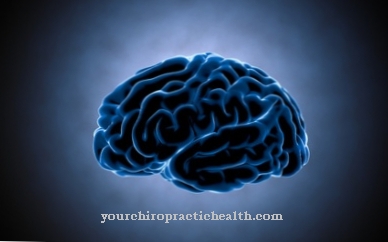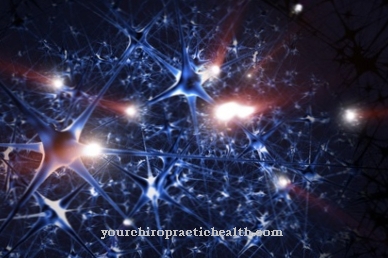In the Denaturation Biomolecules such as proteins and nucleic acids lose their biological activity due to structural changes. However, the primary structure of the biomolecules is retained. There are both necessary and harmful processes of denaturation in the body.
What is denaturation?

Denaturation refers to the destruction of the secondary, tertiary and quaternary structure of proteins and nucleic acids by physical and chemical influences. Physical influences represent heat, pressure or high-energy radiation. Chemically, denaturation is caused by acids, alkalis, chaotropes, detergents, alcohol or other compounds.
Despite these structural changes, however, the primary structure is retained. The primary structure is characterized by the sequence of the amino acids in the proteins or the nitrogen bases in the nucleic acids. The secondary structure describes the folding of biomolecules through the influence of hydrogen bonds, polar interactions, ionic bonds and hydrophobic interactions. Apart from the formation of disulfide bridges between various sulfur-containing amino acids, the other covalent bonds are not changed.
In the tertiary structure, spatial structures form within a biomolecular chain through the folds. The quaternary structure is characterized by the spatial structure formation with several chains. The proteins and nucleic acids develop their biological activity only through the formation of the secondary, tertiary and quaternary structure.
In the case of denaturation, these structures are destroyed by the dissolution of the physical bonds between the individual atomic groups and the chemical bond within the disulfide groups. Although the primary structure is retained, the biological activity is lost.
Denaturations are constantly taking place both outside and inside the body. A typical example of denaturation is the hardening of the egg during cooking. Most denaturations are irreversible. But they can also be reversible.
Function & task
Denaturation takes place constantly in animal and human organisms. The food proteins must first be prepared for chemical splitting into the individual amino acids. This is not possible without exposure of the secondary, tertiary or quaternary structures. The peptidases can only become active when the protein chain is unfolded.
In the stomach, the influence of gastric acid leads to the denaturation of food proteins. After passing through the gatekeeper, the prepared chyme is further chemically broken down by the digestive enzymes of the pancreas. Carbohydrates, fats and proteins are broken down into the corresponding monomers. Under the influence of peptidases, the denatured food proteins produce the individual amino acids, which are converted into the body's own proteins.
The agent for denaturation in the stomach is gastric acid, which largely consists of hydrochloric acid. However, the stomach acid does not only break down food proteins. It also destroys many of the pathogens ingested with food through denaturation.
The denaturation of proteins and nucleic acids also plays an important role in immune defense. Foreign protein particles (germs) and diseased or dead body cells are absorbed and dissolved by so-called macrophages. Their digestion takes place in the so-called lysosomes.Lysosomes are cell organelles that break down foreign substances and the body's own substances with the help of enzymes. Macrophages contain a particularly large number of lysosomes. Inside the lysosomes there is a low pH value (acidic environment). There the protein and nucleic acid components are first denatured and then broken down by digestive enzymes.
In addition, elevated temperatures often occur during an infection. In the case of fever, sensitive germs are also killed by denaturation due to the effect of heat.
Lysosomes are not only contained in macrophages, but also in all other body cells, because in every cell unusable waste products and protein components have to be digested. The denaturation processes described so far are vital for the organism.
You can find your medication here
➔ Medicines for muscle weaknessIllnesses & ailments
However, there are also pathological processes in connection with denaturations that take place within the body. In the case of infections, fever does not only kill germs, because long-term high temperatures can also destroy the body's own proteins. This applies particularly to the very sensitive enzymes. If the body temperature exceeds 40 degrees for a long time, many enzymes become ineffective. Therefore, a very high fever is potentially fatal for the organism. However, if the high temperature drops again within six hours, the damage is still reversible.
Denaturation of proteins is also caused by the influence of heavy metals. Heavy metals can form complexes with proteins. This changes their tertiary and quaternary structures. Here, too, the enzymes are particularly affected. Therefore, heavy metal accumulations in the organism lead to severe chronic and sometimes fatal diseases.
In the case of chemical burns with acids or bases, it is also a question of the denaturation of the body's own proteins in the skin. The death of the affected tissue initiates inflammatory processes that lead to itching and severe skin reactions. In addition, burns lead to denaturation of the body's own proteins in the skin and connective tissue.
Heavy bleeding is often treated with high-frequency electricity in medicine. The tissue temperature is briefly heated up to 80 degrees. As a result, tissue protein and connective tissue fibers coagulate. So the wound can be closed effectively.
Many diseases of old age are also associated with changes in the secondary and tertiary structure of proteins. Although in these cases there is no complete denaturation, folds and plaques occur, among other things. A well-known example is the senile plaques in Alzheimer's patients. The senile plaques are protein deposits in the brain that are formed by folds in the tertiary structure. However, the causes for this process are not yet known. The influence of aluminum on the structural changes of the dew protein is also discussed.













.jpg)

.jpg)
.jpg)











.jpg)